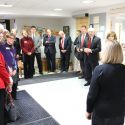Federal grant funds production of stem cells for clinical trials
The long struggle to move the most versatile stem cells from the laboratory to the clinic got another boost with an $8.8 million contract award to the Waisman Clinical Biomanufacturing Facility at the University of Wisconsin–Madison.
The facility, housed in the Waisman Center on campus, contains a series of clean rooms that can manipulate and produce biological products that are pure enough to be used in human therapies.
“Our main function is to understand how to manufacture biological products and biotechnology drugs in a way that can go into human clinical trials,” says Derek Hei, a biochemical engineer who is the facility’s technical director. “We also help investigators follow and interpret Food and Drug Administration rules as they move into clinical trials.”
“This highly competitive award recognizes the outstanding expertise in cell therapy of Derek Hei and his team of affiliated investigators at the Waisman Clinical Biomanufacturing Facility and from across campus,” says Timothy Kamp, director of the university’s Stem Cell and Regenerative Medicine Center. “This resource will certainly help advance the important stem cell biology discoveries made at UW toward clinical treatments. The program will also link UW investigators to a larger network of researchers around the U.S. focused on developing powerful new cell therapies for heart, lung and blood diseases. This grant reflects UW’s continued commitment to bring the power of stem cell biology to exciting new therapies.”
The contract, announced last week by the National Heart, Lung and Blood Institute, will support research at UW–Madison and researchers and firms around the nation, with a focus on projects related to stem cells for treating heart, lung and blood conditions.
The new contract will aid UW–Madison cardiac surgeon Amish Raval, who is investigating how to use bone-marrow stem cells to prevent muscle damage after a heart attack. These stem cells make compounds that reduce inflammation, a major cause of damage to heart muscle in the weeks following a blood stoppage. To move forward with clinical trials, Raval needs a stable, safe and repeatable supply of these stem cells.
The specialized personnel and facilities needed to produce those cells in accordance with FDA standards are extremely expensive, Hei adds.
Biological therapies must overcome a specialized set of hurdles in addition to those standing in the way of conventional pharmaceuticals, says Hei. “For cell therapies, we don’t have a way to sterilize the product at the end, so the clean rooms have to be especially clean, must follow aseptic practices from beginning to end. These rooms are under positive pressure, and have specific equipment, incubators, centrifuges, freezers, that are set up for processing stem cells and other biologics.”
Air monitors in the clean rooms are used to detect any living contaminants, and many workers must wear head-to-toe gowns. The end point of the small-scale manufacturing process is in many cases a box of vials holding biological treatments ready to be injected during human trials.
Because biological products are based on DNA, they are more variable than the chemicals in conventional drugs, and when experiments conflict, the problem is often traced to genetic variations in the starting material. To overcome this hurdle, the Biomanufacturing Facility maintains a set of ultra-cold freezers that store cells for its clients, Hei says. “Once an investigator has proven safety and efficacy in animal studies, we can provide them with more of the exact same cells for the next stage in development — human clinical trials. Otherwise, they might have to go back and start over with a new batch of cells, and that wastes time and money.”
While the healing potential of embryonic stem cells, which were first isolated at UW–Madison in 1998, remains largely in the future, Hei says researchers are forging ahead. “This type of development is very complicated. After a discovery happens, it typically takes 15 or 20 years to see a payoff, to work out the details, the manufacturing and delivery, to get through all the stages of clinical trials to prove safety and efficacy. I think we are likely 10 years off before we see the major successes in embryonic stem cells and related treatments, but we are really moving ahead.”
Tags: research, stem cells, Waisman Center



